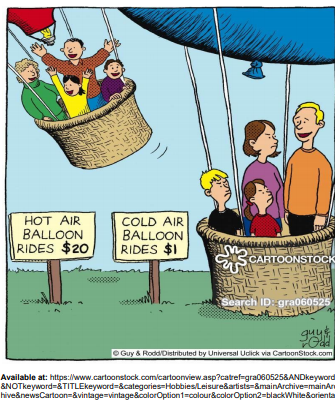Questões de Vestibular
Comentadas sobre interpretação de texto | reading comprehension em inglês
Foram encontradas 680 questões

Available at: www.comics.azcentral.com. Accessed on March 28th, 2019.
Answer the question according to Text.
The expression: “I`m sold, Nate”, in the second picture, means:
Read the following cartoon in order to answer QUESTION .

From the cartoon, it is CORRECT to affirm:
Read the following cartoon:

The cartoon infers the idea:
Leia o texto para responder à questão.
America’s social-media addiction is getting worse

(Sources: Pew Research Centre; e Marketer)
A survey in January and February 2019 from the Pew Research Centre, a think tank, found that 69% of American adults use Facebook; of these users, more than half visit the site “several times a day”. YouTube is even more popular, with 73% of adults saying they watch videos on the platform. For those aged 18 to 24, the figure is 90%. Instagram, a photo-sharing app, is used by 37% of adults. When Pew first conducted the survey in 2012, only a slim majority of Americans used Facebook. Fewer than one in ten had an Instagram account.
Americans are also spending more time than ever on social-media sites like Facebook. There is evidence that limiting such services might yield health benefits. A paper published last year by Melissa Hunt, Rachel Marx, Courtney Lipson and Jordyn Young, all of the University of Pennsylvania, found that limiting social-media usage to 10 minutes a day led to reductions in loneliness, depression, anxiety and fear. Another paper from 2014 identified a link between heavy social-media usage and depression, largely due to a “social comparison” phenomenon, whereby users compare themselves to others and come away with lower evaluations of themselves.
(www.economist.com, 08.08.2019. Adaptado.)
Leia o texto para responder à questão.
America’s social-media addiction is getting worse

(Sources: Pew Research Centre; e Marketer)
A survey in January and February 2019 from the Pew Research Centre, a think tank, found that 69% of American adults use Facebook; of these users, more than half visit the site “several times a day”. YouTube is even more popular, with 73% of adults saying they watch videos on the platform. For those aged 18 to 24, the figure is 90%. Instagram, a photo-sharing app, is used by 37% of adults. When Pew first conducted the survey in 2012, only a slim majority of Americans used Facebook. Fewer than one in ten had an Instagram account.
Americans are also spending more time than ever on social-media sites like Facebook. There is evidence that limiting such services might yield health benefits. A paper published last year by Melissa Hunt, Rachel Marx, Courtney Lipson and Jordyn Young, all of the University of Pennsylvania, found that limiting social-media usage to 10 minutes a day led to reductions in loneliness, depression, anxiety and fear. Another paper from 2014 identified a link between heavy social-media usage and depression, largely due to a “social comparison” phenomenon, whereby users compare themselves to others and come away with lower evaluations of themselves.
(www.economist.com, 08.08.2019. Adaptado.)
Leia o texto para responder à questão.
America’s social-media addiction is getting worse

(Sources: Pew Research Centre; e Marketer)
A survey in January and February 2019 from the Pew Research Centre, a think tank, found that 69% of American adults use Facebook; of these users, more than half visit the site “several times a day”. YouTube is even more popular, with 73% of adults saying they watch videos on the platform. For those aged 18 to 24, the figure is 90%. Instagram, a photo-sharing app, is used by 37% of adults. When Pew first conducted the survey in 2012, only a slim majority of Americans used Facebook. Fewer than one in ten had an Instagram account.
Americans are also spending more time than ever on social-media sites like Facebook. There is evidence that limiting such services might yield health benefits. A paper published last year by Melissa Hunt, Rachel Marx, Courtney Lipson and Jordyn Young, all of the University of Pennsylvania, found that limiting social-media usage to 10 minutes a day led to reductions in loneliness, depression, anxiety and fear. Another paper from 2014 identified a link between heavy social-media usage and depression, largely due to a “social comparison” phenomenon, whereby users compare themselves to others and come away with lower evaluations of themselves.
(www.economist.com, 08.08.2019. Adaptado.)
Leia o texto para responder à questão.
America’s social-media addiction is getting worse

(Sources: Pew Research Centre; e Marketer)
A survey in January and February 2019 from the Pew Research Centre, a think tank, found that 69% of American adults use Facebook; of these users, more than half visit the site “several times a day”. YouTube is even more popular, with 73% of adults saying they watch videos on the platform. For those aged 18 to 24, the figure is 90%. Instagram, a photo-sharing app, is used by 37% of adults. When Pew first conducted the survey in 2012, only a slim majority of Americans used Facebook. Fewer than one in ten had an Instagram account.
Americans are also spending more time than ever on social-media sites like Facebook. There is evidence that limiting such services might yield health benefits. A paper published last year by Melissa Hunt, Rachel Marx, Courtney Lipson and Jordyn Young, all of the University of Pennsylvania, found that limiting social-media usage to 10 minutes a day led to reductions in loneliness, depression, anxiety and fear. Another paper from 2014 identified a link between heavy social-media usage and depression, largely due to a “social comparison” phenomenon, whereby users compare themselves to others and come away with lower evaluations of themselves.
(www.economist.com, 08.08.2019. Adaptado.)
Leia o texto para responder à questão.
America’s social-media addiction is getting worse

(Sources: Pew Research Centre; e Marketer)
A survey in January and February 2019 from the Pew Research Centre, a think tank, found that 69% of American adults use Facebook; of these users, more than half visit the site “several times a day”. YouTube is even more popular, with 73% of adults saying they watch videos on the platform. For those aged 18 to 24, the figure is 90%. Instagram, a photo-sharing app, is used by 37% of adults. When Pew first conducted the survey in 2012, only a slim majority of Americans used Facebook. Fewer than one in ten had an Instagram account.
Americans are also spending more time than ever on social-media sites like Facebook. There is evidence that limiting such services might yield health benefits. A paper published last year by Melissa Hunt, Rachel Marx, Courtney Lipson and Jordyn Young, all of the University of Pennsylvania, found that limiting social-media usage to 10 minutes a day led to reductions in loneliness, depression, anxiety and fear. Another paper from 2014 identified a link between heavy social-media usage and depression, largely due to a “social comparison” phenomenon, whereby users compare themselves to others and come away with lower evaluations of themselves.
(www.economist.com, 08.08.2019. Adaptado.)
Leia o texto para responder à questão.
America’s social-media addiction is getting worse

(Sources: Pew Research Centre; e Marketer)
A survey in January and February 2019 from the Pew Research Centre, a think tank, found that 69% of American adults use Facebook; of these users, more than half visit the site “several times a day”. YouTube is even more popular, with 73% of adults saying they watch videos on the platform. For those aged 18 to 24, the figure is 90%. Instagram, a photo-sharing app, is used by 37% of adults. When Pew first conducted the survey in 2012, only a slim majority of Americans used Facebook. Fewer than one in ten had an Instagram account.
Americans are also spending more time than ever on social-media sites like Facebook. There is evidence that limiting such services might yield health benefits. A paper published last year by Melissa Hunt, Rachel Marx, Courtney Lipson and Jordyn Young, all of the University of Pennsylvania, found that limiting social-media usage to 10 minutes a day led to reductions in loneliness, depression, anxiety and fear. Another paper from 2014 identified a link between heavy social-media usage and depression, largely due to a “social comparison” phenomenon, whereby users compare themselves to others and come away with lower evaluations of themselves.
(www.economist.com, 08.08.2019. Adaptado.)
Leia o texto para responder à questão.
America’s social-media addiction is getting worse

(Sources: Pew Research Centre; e Marketer)
A survey in January and February 2019 from the Pew Research Centre, a think tank, found that 69% of American adults use Facebook; of these users, more than half visit the site “several times a day”. YouTube is even more popular, with 73% of adults saying they watch videos on the platform. For those aged 18 to 24, the figure is 90%. Instagram, a photo-sharing app, is used by 37% of adults. When Pew first conducted the survey in 2012, only a slim majority of Americans used Facebook. Fewer than one in ten had an Instagram account.
Americans are also spending more time than ever on social-media sites like Facebook. There is evidence that limiting such services might yield health benefits. A paper published last year by Melissa Hunt, Rachel Marx, Courtney Lipson and Jordyn Young, all of the University of Pennsylvania, found that limiting social-media usage to 10 minutes a day led to reductions in loneliness, depression, anxiety and fear. Another paper from 2014 identified a link between heavy social-media usage and depression, largely due to a “social comparison” phenomenon, whereby users compare themselves to others and come away with lower evaluations of themselves.
(www.economist.com, 08.08.2019. Adaptado.)
Leia o texto para responder à questão.
America’s social-media addiction is getting worse

(Sources: Pew Research Centre; e Marketer)
A survey in January and February 2019 from the Pew Research Centre, a think tank, found that 69% of American adults use Facebook; of these users, more than half visit the site “several times a day”. YouTube is even more popular, with 73% of adults saying they watch videos on the platform. For those aged 18 to 24, the figure is 90%. Instagram, a photo-sharing app, is used by 37% of adults. When Pew first conducted the survey in 2012, only a slim majority of Americans used Facebook. Fewer than one in ten had an Instagram account.
Americans are also spending more time than ever on social-media sites like Facebook. There is evidence that limiting such services might yield health benefits. A paper published last year by Melissa Hunt, Rachel Marx, Courtney Lipson and Jordyn Young, all of the University of Pennsylvania, found that limiting social-media usage to 10 minutes a day led to reductions in loneliness, depression, anxiety and fear. Another paper from 2014 identified a link between heavy social-media usage and depression, largely due to a “social comparison” phenomenon, whereby users compare themselves to others and come away with lower evaluations of themselves.
(www.economist.com, 08.08.2019. Adaptado.)
Examine o quadrinho de Peter Steiner para responder à questão.

(https://condenaststore.com)
Examine o quadrinho de Peter Steiner para responder à questão.

(https://condenaststore.com)
Examine o cartum de Liana Finck, publicado em sua conta no Instagram em 13.08.2019.

No cartum, a casa pode ser vista como uma metáfora da
Read the following advertisement in order to answer QUESTION.

The 1961 Kenwood Chef advertisement suggests:

O efeito de comicidade que se obtém do meme decorre,
sobretudo, da
Observe o infográfico a seguir para responder à questão .

According to the information expressed in the image and the data, The Global Goals, we verify that the
Look at the pictures of the advertising campaign created by Fosbury&Brothers.


The purpose of the campaign is to show that smoking
Observe the image.

(www.michaelkonik.com, 05.10.2013.)
The art print overlaps
What does love look like? Love is accepting that your partner is not perfect, but you want to be with him or her anyway. Love is being grateful that you are accepted despite your imperfections. Love is still being happy to come home to that same person, even after 30 years.